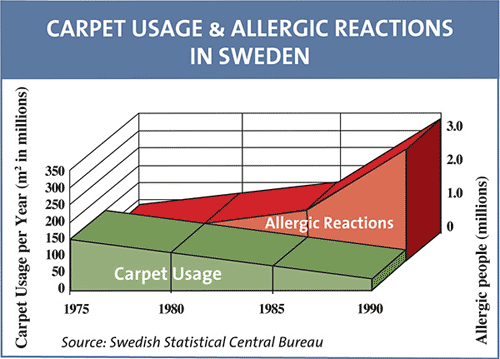Carpet for Schools: A Sustainable Solution that Enhances Learning and Health
The reason is that allergies are usually affected by airborne particles. Carpet traps allergens in its fiber and does not allow them to circulate in the air, even with the activity of children. The allergens trapped in the carpet then can be easily removed by adhering to a regular cleaning and maintenance schedule that includes vacuuming and periodic extraction cleaning using Seal of Approval-certified products. Studies have compared the distribution of airborne dust associated with normal activities on hard and soft flooring surfaces. In 2002, research by G. Asbury titled, "Cleaning and Foot Traffic Emissions Analysis," for the Professional Testing Laboratory, Inc., in Dalton, Georgia, showed that walking on hard surfaces disturbed more particles. These particles became airborne and entered the breathing zone. In contrast, carpeted surfaces trapped more particles so that walking disturbed fewer particles. The result was less dust in the breathing zone over carpeted floors.
In another study by Research Triangle Institute (RTI) and University of North Carolina (UNC) researchers investigated two schools in North Carolina from the same school district and situated in rural locations with very similar outdoor environmental conditions (Proceedings: Indoor Air 2002, Monterey California � A Comparison of Biocontaminant Levels Associated with Hard vs. Carpet Floors in Non-Problem Schools; Results of a Yearlong Study.) Both schools followed almost identical cleaning programs. One school was mostly resilient vinyl tile floors while the other school had 70 percent to 75 percent carpet floors. The study found that, although the carpet flooring had higher concentrations of biocontaminants than an equal area of tiled floor, airborne contaminants were higher over tiled floors than over carpet.
Yet another investigation of thirteen Florida classrooms encompassing six schools presented at the 1996 International Indoor Air Quality Conference, concluded that carpet does not contribute to air quality problems:Â "Carpet can serve as a reservoir for nonviable spores that enter from the outside, yet there is no evidence to indicate mold spores or mite allergen leave the carpet."
In a government study in Sweden, when carpet was banned from public buildings and replaced with smooth surfaces, carpet's share of the total floorcovering market dropped from 40 percent in the mid-70s to only 2 percent in 1992. During this same time period, the incidence of allergies among Swedes increased approximately four-fold. The study authors believed that allergic reactions in sensitive individuals were not directly associated with carpet, but rather indoor air quality.
Dr. Hedge reports that carpet can improve indoor air quality because carpet captures and holds dirt, contaminants and allergens that would otherwise become airborne - "as long as schools keep floors clean and use high-efficiency microfiltration vacuum bags, carpets can be a healthy, safe and economical floor covering in schools and day care centers. Microfiltration bags will trap very small particles, such as dust mites and feces, so that these will not become airborne."

Another indoor air quality issue is that of carpet and mold. Clean carpet does not support mold growth even at prolonged and elevated temperatures. However, left unresolved, leaks and spills, heavy condensation and localized flooding, especially when followed by prolonged high humidity, can lead to mold growth in many areas of a school. For mold to grow, it needs water, oxygen, a warm temperature and something that contains nutrients to feed on, such as dirt, wood or paper. Moisture trapped below a carpet can result in mold growth and the release of mold spores and mold metabolic products (microbial volatile organic compounds (VOCs or MVOCs) into indoor air. Effective moisture control is critical to protect all building systems from the potential for mold growth. That said, studies have shown that the biggest source of mold spores is actually an improperly operated and maintained HVAC system. Shutting the HVAC system off at night or during downtime creates the perfect incubator for mold spores, which are then flushed into the breathing zone.
Indoor air quality also involves the emissions of volatile organic compound (VOC) levels from building materials. Carpet may be the lowest VOC emitter of common flooring choices and one of the lowest emitting products used in new construction and renovation, much lower than products such as paint. The already low VOC emission of new carpet drops significantly after 24 hours, even sooner with fresh air ventilation. According to Werner Braun of the Carpet and Rug Institute, the industry has developed a program known as the Indoor Air Quality Green Label Program to determine the level of VOC emissions from carpet, floor adhesives, and cushion products. Attached to a carpet, floor adhesive or cushion, the label signifies that a representative sample of the product type has been tested by an independent laboratory. The recent Green Label Plus is an enhancement that incorporates additional requirements to meet California's Collaborative for High Performance Schools (CHPS) low-emitting materials criteria. Products listed as CHPS-compliant materials have been chamber tested to meet the indoor air quality guidelines outlined in California's specification section 01350.









